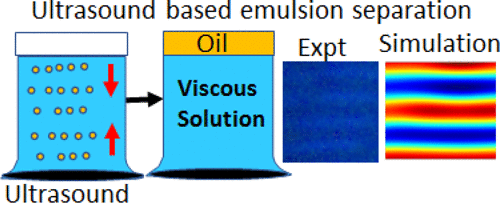当前位置:
X-MOL 学术
›
Ind. Eng. Chem. Res.
›
论文详情
Our official English website, www.x-mol.net, welcomes your feedback! (Note: you will need to create a separate account there.)
Effect of Bulk Viscosity and Emulsion Droplet Size on the Separation Efficiency of Model Mineral Oil-in-Water (O/W) Emulsions under Ultrasonic Standing Wave Fields: A Theoretical and Experimental Investigation
Industrial & Engineering Chemistry Research ( IF 4.2 ) Pub Date : 2020-04-02 , DOI: 10.1021/acs.iecr.0c00616 Srinivas Mettu 1, 2 , Shunyu Yao 1 , Qiang Sun 3 , Samuel Ronald Lawson 1 , Peter J. Scales 3 , Gregory J. O. Martin 3 , Muthupandian Ashokkumar 1
Industrial & Engineering Chemistry Research ( IF 4.2 ) Pub Date : 2020-04-02 , DOI: 10.1021/acs.iecr.0c00616 Srinivas Mettu 1, 2 , Shunyu Yao 1 , Qiang Sun 3 , Samuel Ronald Lawson 1 , Peter J. Scales 3 , Gregory J. O. Martin 3 , Muthupandian Ashokkumar 1
Affiliation

|
Ultrasound standing waves can be used to separate emulsions. So far, they have been applied to oil-in-water emulsions with low continuous phase viscosity. This technique has the potential to be used for novel applications such as separating lipids from algal biomass; however, this requires the methodology to be optimized to process viscous emulsions. We have addressed this issue by studying the effects of bulk phase viscosity (1–23 mPa·s), emulsion droplet size (4.5–20 μm), power (10–54 W/L), and frequency (1 and 2 MHz) of ultrasound on the separation efficiency of model mineral oil-in-water–glycerol-mixture emulsions. For the small droplet size (4.5 μm) emulsion in water, the maximum separation achieved increased from 36 to 79% when ultrasound power increased from 10 to 54 W/L. However, for the large droplet size (11 μm) emulsion, the maximum separation was greater than 95% and was independent of ultrasound power. The maximum separation efficiency for small droplet size (4.5–6 μm) emulsions decreased from 80 to 14% when the viscosity increased from 1 to 23 mPa·s. However, for the large droplet size (11–20 μm) emulsion, the maximum separation efficiency decreased from 98 to 62% when the viscosity of the bulk phase was increased from 1 to 23 mPa·s. The experimental results were then interpreted using analytical and numerical simulations by calculating the time required for the emulsion droplets to migrate to the nearest pressure antinodal plane under the influence of ultrasound standing waves. Further experiments showed that increasing the ultrasound frequency from 1 to 2 MHz increased the maximum separation from 36 to 86% for fine emulsions and water as the continuous phase.
中文翻译:

超声驻波场下本体粘度和乳液滴尺寸对模型水包油(O / W)乳液分离效率的影响:理论和实验研究
超声波驻波可用于分离乳液。迄今为止,它们已被用于具有低连续相粘度的水包油型乳液。该技术有潜力用于新的应用,例如从藻类生物质中分离脂质;但是,这需要优化方法以处理粘性乳液。我们通过研究体相粘度(1–23 mPa·s),乳剂液滴尺寸(4.5–20μm),功率(10–54 W / L)和频率(1和2 MHz)的影响解决了这个问题对模型矿物油-水-甘油混合物乳液分离效率的影响 对于水中的小液滴尺寸(4.5μm)乳液,当超声功率从10 W / L增加到54 W / L时,最大分离度从36%增加到79%。但是,对于大液滴尺寸(11μm)的乳液,最大分离度大于95%,并且与超声功率无关。当粘度从1 mPa·s增加到23 mPa·s时,小液滴尺寸(4.5–6μm)乳液的最大分离效率从80%降低到14%。但是,对于大液滴尺寸(11–20μm)的乳液,当本体相的粘度从1 mPa·s增加到23 mPa·s时,最大分离效率从98%降低到62%。然后,通过计算乳剂液滴在超声驻波影响下迁移到最近的压力抗结平面所需的时间,使用分析和数值模拟来解释实验结果。进一步的实验表明,对于细乳液和水作为连续相,将超声频率从1 MHz增加到2 MHz可以将最大分离度从36%增加到86%。
更新日期:2020-04-24
中文翻译:

超声驻波场下本体粘度和乳液滴尺寸对模型水包油(O / W)乳液分离效率的影响:理论和实验研究
超声波驻波可用于分离乳液。迄今为止,它们已被用于具有低连续相粘度的水包油型乳液。该技术有潜力用于新的应用,例如从藻类生物质中分离脂质;但是,这需要优化方法以处理粘性乳液。我们通过研究体相粘度(1–23 mPa·s),乳剂液滴尺寸(4.5–20μm),功率(10–54 W / L)和频率(1和2 MHz)的影响解决了这个问题对模型矿物油-水-甘油混合物乳液分离效率的影响 对于水中的小液滴尺寸(4.5μm)乳液,当超声功率从10 W / L增加到54 W / L时,最大分离度从36%增加到79%。但是,对于大液滴尺寸(11μm)的乳液,最大分离度大于95%,并且与超声功率无关。当粘度从1 mPa·s增加到23 mPa·s时,小液滴尺寸(4.5–6μm)乳液的最大分离效率从80%降低到14%。但是,对于大液滴尺寸(11–20μm)的乳液,当本体相的粘度从1 mPa·s增加到23 mPa·s时,最大分离效率从98%降低到62%。然后,通过计算乳剂液滴在超声驻波影响下迁移到最近的压力抗结平面所需的时间,使用分析和数值模拟来解释实验结果。进一步的实验表明,对于细乳液和水作为连续相,将超声频率从1 MHz增加到2 MHz可以将最大分离度从36%增加到86%。



























 京公网安备 11010802027423号
京公网安备 11010802027423号